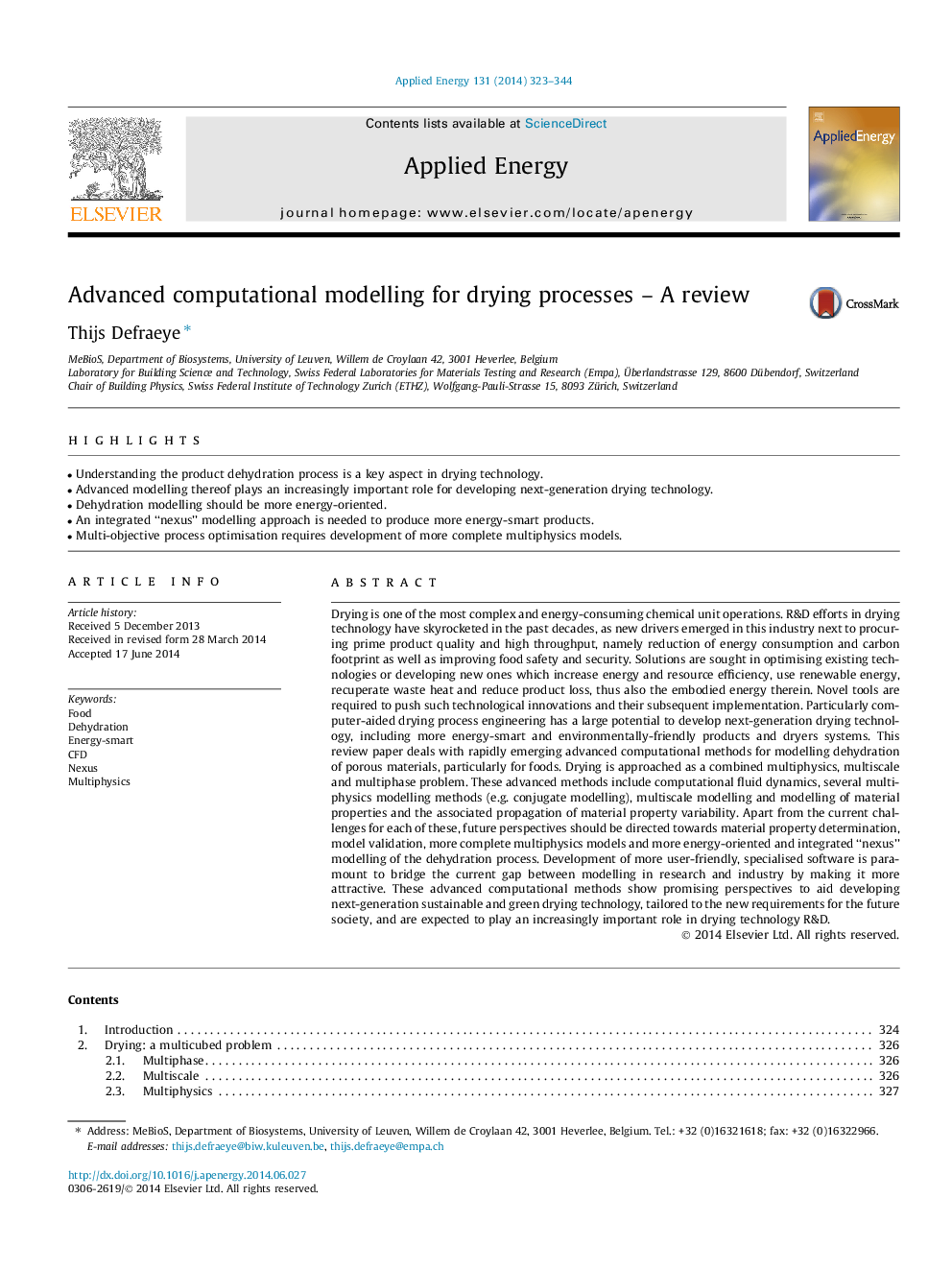| کد مقاله | کد نشریه | سال انتشار | مقاله انگلیسی | نسخه تمام متن |
|---|---|---|---|---|
| 6690066 | 501893 | 2014 | 22 صفحه PDF | دانلود رایگان |
عنوان انگلیسی مقاله ISI
Advanced computational modelling for drying processes - A review
ترجمه فارسی عنوان
مدلسازی پیشرفته محاسباتی برای فرایندهای خشک کردن - بررسی
دانلود مقاله + سفارش ترجمه
دانلود مقاله ISI انگلیسی
رایگان برای ایرانیان
کلمات کلیدی
ترجمه چکیده
خشک کردن یکی از پیچیده ترین و انرژی مصرفی عملیات واحد شیمیایی است. تلاش های تحقیق و توسعه در زمینه تکنولوژی خشک کردن در دهه های گذشته، پیشرفت های جدیدی در این صنعت در کنار کیفیت اولیه و کیفیت بالای محصول، یعنی کاهش مصرف انرژی و رد پای کربن، و نیز بهبود ایمنی و امنیت غذایی انجام شده است. راه حل ها به منظور بهینه سازی فن آوری های موجود و یا توسعه ی موارد جدیدی است که باعث افزایش بهره وری منابع و انرژی، استفاده از انرژی های تجدیدپذیر، احیاء گرمادهی و کاهش تلفات محصول می شود، و همچنین انرژی تجدید شده در آن، مورد بررسی قرار می گیرد. ابزارهای رمان برای تحریک چنین نوآوری های تکنولوژیکی و اجرای پیوسته آنها ضروری هستند. به خصوص مهندسی فرایند خشک کردن کامپیوتر با استفاده از فن آوری های پخت و پز، پتانسیل بالایی برای توسعه نسل بعدی تکنولوژی خشک کردن، از جمله محصولات انرژی های هوشمند و محیط زیست و سیستم های خشک کن. این مقاله بررسی روشهای پیشرفته محاسباتی پیشرفته برای مدل سازی کم آبی بدن مواد متخلخل، به ویژه برای مواد غذایی است. خشک کردن به عنوان یک ترکیب چند فازی، چند و چند فاز در نظر گرفته شده است. این روش های پیشرفته شامل پویایی سیالات محاسباتی، چندین روش مدل سازی چند فازی (به عنوان مثال مدل سازی کنژوگه)، مدل سازی چند بعدی و مدل سازی خواص مواد و انتشار مرتبط با تغییرات ویژگی های مواد است. به غیر از چالش های فعلی برای هر یک از این، دیدگاه های آینده باید به منظور تعیین ویژگی های مواد، اعتبار مدل، مدل های چند فیزیک کامل و بیشتر انرژی گرا و یکپارچه؟ مدل سازی فرآیند کم آبیاری. توسعه نرم افزار تخصصی تر، نرم افزار تخصصی برای تحقق شکاف فعلی بین مدل سازی در تحقیقات و صنعت با ایجاد آن جذاب تر است. این روشهای پیشرفته محاسباتی چشم اندازهای امیدوار کننده ای را برای کمک به توسعه تکنولوژی خشک کردن پایدار و سبز نسل آینده مطابق با الزامات جدید برای جامعه آینده نشان می دهد و انتظار می رود که نقش مهمی در خشک کردن فناوری تحقیق و توسعه بازی کند.
موضوعات مرتبط
مهندسی و علوم پایه
مهندسی انرژی
مهندسی انرژی و فناوری های برق
چکیده انگلیسی
Drying is one of the most complex and energy-consuming chemical unit operations. R&D efforts in drying technology have skyrocketed in the past decades, as new drivers emerged in this industry next to procuring prime product quality and high throughput, namely reduction of energy consumption and carbon footprint as well as improving food safety and security. Solutions are sought in optimising existing technologies or developing new ones which increase energy and resource efficiency, use renewable energy, recuperate waste heat and reduce product loss, thus also the embodied energy therein. Novel tools are required to push such technological innovations and their subsequent implementation. Particularly computer-aided drying process engineering has a large potential to develop next-generation drying technology, including more energy-smart and environmentally-friendly products and dryers systems. This review paper deals with rapidly emerging advanced computational methods for modelling dehydration of porous materials, particularly for foods. Drying is approached as a combined multiphysics, multiscale and multiphase problem. These advanced methods include computational fluid dynamics, several multiphysics modelling methods (e.g. conjugate modelling), multiscale modelling and modelling of material properties and the associated propagation of material property variability. Apart from the current challenges for each of these, future perspectives should be directed towards material property determination, model validation, more complete multiphysics models and more energy-oriented and integrated “nexus” modelling of the dehydration process. Development of more user-friendly, specialised software is paramount to bridge the current gap between modelling in research and industry by making it more attractive. These advanced computational methods show promising perspectives to aid developing next-generation sustainable and green drying technology, tailored to the new requirements for the future society, and are expected to play an increasingly important role in drying technology R&D.
ناشر
Database: Elsevier - ScienceDirect (ساینس دایرکت)
Journal: Applied Energy - Volume 131, 15 October 2014, Pages 323-344
Journal: Applied Energy - Volume 131, 15 October 2014, Pages 323-344
نویسندگان
Thijs Defraeye,
